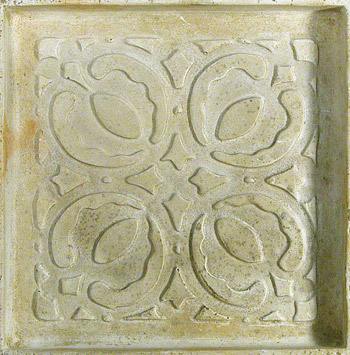Deerfield Arts & Crafts home page
Comparisons
E. Miller and C. Thomas Pomegranates


When Chauncey Thomas moved from Deerfield to California, he took with him this pomegranate tile design. We know that the pomegranate motif, as it appeared in 18th-century western Massachusetts embroideries, was first studied by Deerfield Society of Blue and White Needlework founders Ellen Miller and Margaret Whiting in the late 19th century. Eventually, Ellen Miller designed a series of pomegranate squares. The series was unified by individual or groups of pomegranate fruit nestled into the four corners of each work. Sometime between 1909 and 1911 Chauncey Thomas came up with his own version of the pomegranate square. We do not know if his design preceded, followed or was contemporary with Ellen Miller's pomegranate square designs, but Thomas' tile too features a four quadrant arrangement of stylized pomegranates.
While he was in Deerfield, it is likely that the potter Chauncey Thomas, a student of Arthur Wesley Dow and the only professionally trained craftsman (as opposed to professionally-trained fine artist) involved in the Deerfield Arts and Crafts movement, influenced the direction of Deerfield's Arts and Crafts designs. As is evidenced by his choice of the stylized pomegranate motif, however, that influence was not likely unidirectional.
Left image: Pomegranate Square, Ellen Miller, Memorial Hall Museum, Pocumtuck Valley Memorial Association
Right image: Chauncey Thomas Tile, Chauncey R. Thomas, Courtesy of William Kirby Brown